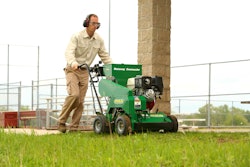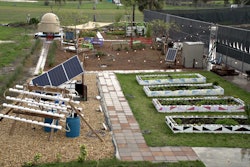 Photo: Anthony Tesselaar Plants
Photo: Anthony Tesselaar PlantsIn a green industry professional’s perfect world, a landscape would consist of excellent soil, light, weather conditions and minimal diseases and pests. But, as you know better than most, Mother Nature has a mind of her own that can rarely be changed.
Since resourcefulness is a must in the green industry, knowing how to work around dry areas, contend with uncooperative soil, fix uncolorful areas, take advantage of small spaces and more can prove beneficial in all areas of your work.
According to a trends report done by the American Society of Landscape Architects (ASLA), popularity continues to grow on native/adapted drought-tolerant plants, low-maintenance landscapes and reduced lawn areas.
One of the easiest ways to tackle all of these issues is to harness the power of problem-solving plants. Read on to find out more about the best ways to handle these and other typical gardening challenges.
Colors
Dry areas
The erratic appearances of precipitation nationwide continue to be an issue for landscapers, with more and more areas experiencing droughts.
When customers want beautiful, colorful plants but aren’t crazy about running up their water bill, it’s important to have a few ideas on hand instead of just utilizing rocks and mulch.
Picking the right plants to provide coverage and color is now simpler and doesn’t require you to sacrifice sustainability in the process. When dealing with areas that need to be more water-wise, Flower Carpet roses and Storm agapanthus are great options.
According to Nan Sterman’s book “Hot Color, Dry Garden,” Flower Carpet roses are some of the most drought-tolerant roses, especially in coastal Mediterranean climates.
With a two-tier root system that allows these roses to withstand drought conditions without slowing down, Sterman says the surface roots are able to take in new moisture from rain or others waterings. Established roots are able to develop taproots that reach lower-level groundwater, as well.
Additionally, these roses are humidity, heat and disease resistant, and they work well in large commercial areas and are great for stabilizing slopes.
Proving equally useful and aesthetically pleasing in the landscape are Storm agapanthus, which are compact growers. They can produce up to 100 flowers on each plant and are available in white and blue. Another perk of this plant is its fire-retardant, fleshy leaves.
Late season color
It’s no secret that by the end of the blooming season, many plants in the landscape are worn out from the elements and pests, but that’s not always the case with Volcano phlox.
With these beauties, there’s no need to stake them, and powdery mildew is virtually nonexistent. These traits, along with their growing habits, a plethora of blooms and bright, eye-catching colors, make them a favorite for late season color.
They come in bi-color, purple, pink, rose and lilac, which gives your customers the chance to have an array throughout their landscape.
Containers and small areas
For customers with a fair amount of container plants around, it’s important to keep them bright, well-maintained and attractive to those who come in contact with them.
Since these plants are likely to stay in one place for an extended amount of time and will be seen by the masses regularly, finding plants that can take beatings from many different sources is beneficial.
While it’s a good idea to stick tougher evergreens in these containers, there are a few other options that will offer resiliency as well as a pop of color. Both the Tropicanna cannas and the Bonfire begonia will add a fair amount of color to containers and won’t require much maintenance after they’ve been planted.
Both plants help with the traditional container design idea of spiller, filler and thriller, as the Tropicannas are upright when they grow and the Bonfires have more of a trailing tendency.
With more and more customers opting for smaller houses and smaller yards, the options for landscaping design can become difficult.
Even though the space might be cut in half, customers are still going to crave that beautiful, well-kept garden look they’ve had in the past, and it’s up to you to find out what best fits in these areas.
Smaller flowering trees can be a great way to bring life into a smaller space, while still offering the environmental benefits of bigger trees.
Jury magnolias bring a lot of color to the table without taking up an ample amount of space, and they feature large, impressive blooms that measure 6-12 inches wide. The blooms come in shades of burgundy, cream, deep purple and pink, and they typically grow to a maximum of 12-15 feet tall and 3-4 feet wide.
To find a few more beautiful and eye-catching smaller tree options your clients are sure to love, click here.











